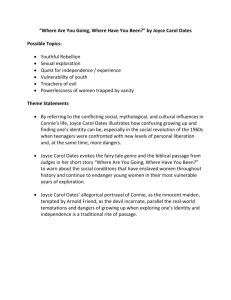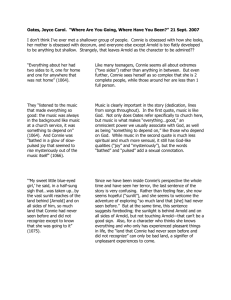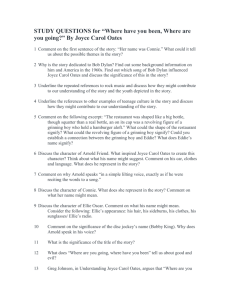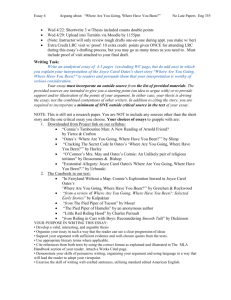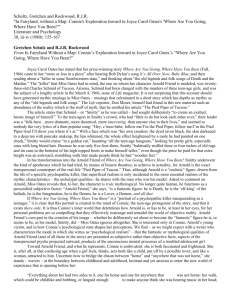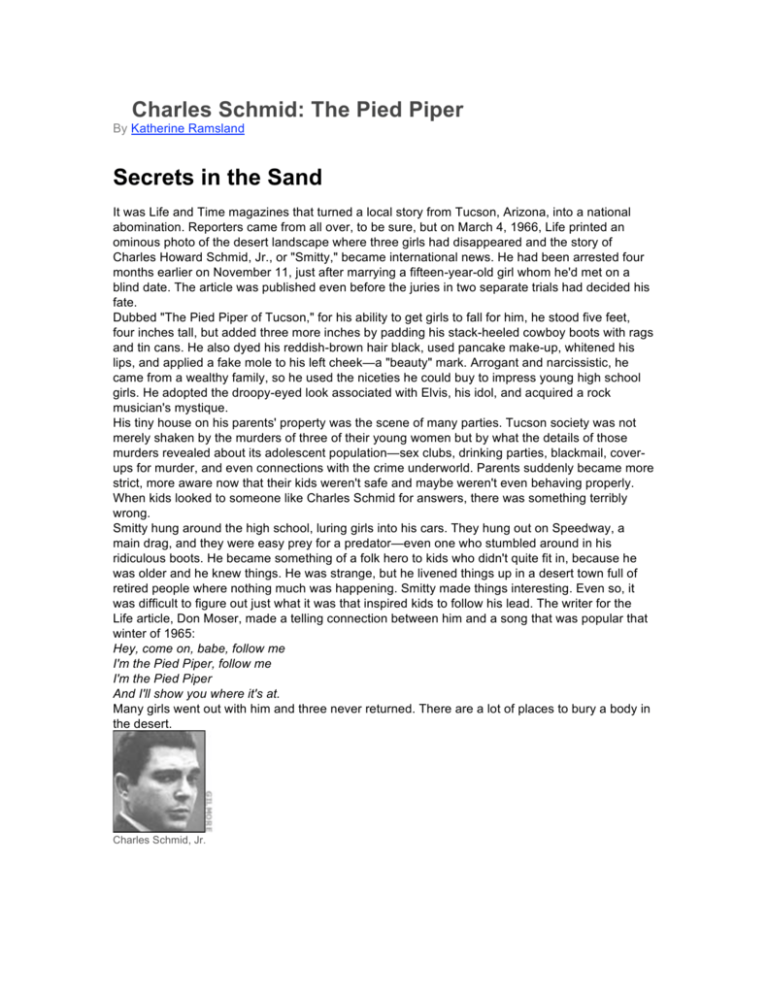
Charles Schmid: The Pied Piper
By Katherine Ramsland
Secrets in the Sand
It was Life and Time magazines that turned a local story from Tucson, Arizona, into a national
abomination. Reporters came from all over, to be sure, but on March 4, 1966, Life printed an
ominous photo of the desert landscape where three girls had disappeared and the story of
Charles Howard Schmid, Jr., or "Smitty," became international news. He had been arrested four
months earlier on November 11, just after marrying a fifteen-year-old girl whom he'd met on a
blind date. The article was published even before the juries in two separate trials had decided his
fate.
Dubbed "The Pied Piper of Tucson," for his ability to get girls to fall for him, he stood five feet,
four inches tall, but added three more inches by padding his stack-heeled cowboy boots with rags
and tin cans. He also dyed his reddish-brown hair black, used pancake make-up, whitened his
lips, and applied a fake mole to his left cheek—a "beauty" mark. Arrogant and narcissistic, he
came from a wealthy family, so he used the niceties he could buy to impress young high school
girls. He adopted the droopy-eyed look associated with Elvis, his idol, and acquired a rock
musician's mystique.
His tiny house on his parents' property was the scene of many parties. Tucson society was not
merely shaken by the murders of three of their young women but by what the details of those
murders revealed about its adolescent population—sex clubs, drinking parties, blackmail, coverups for murder, and even connections with the crime underworld. Parents suddenly became more
strict, more aware now that their kids weren't safe and maybe weren't even behaving properly.
When kids looked to someone like Charles Schmid for answers, there was something terribly
wrong.
Smitty hung around the high school, luring girls into his cars. They hung out on Speedway, a
main drag, and they were easy prey for a predator—even one who stumbled around in his
ridiculous boots. He became something of a folk hero to kids who didn't quite fit in, because he
was older and he knew things. He was strange, but he livened things up in a desert town full of
retired people where nothing much was happening. Smitty made things interesting. Even so, it
was difficult to figure out just what it was that inspired kids to follow his lead. The writer for the
Life article, Don Moser, made a telling connection between him and a song that was popular that
winter of 1965:
Hey, come on, babe, follow me
I'm the Pied Piper, follow me
I'm the Pied Piper
And I'll show you where it's at.
Many girls went out with him and three never returned. There are a lot of places to bury a body in
the desert.
Charles Schmid, Jr.
Inspiration for Joyce Carol Oates
The short story, "Where Are You Going, Where Have You Been?" written by Joyce Carol Oates
and published in 1966, was based on the tale of Charles Schmid. Oates had read part of the
article printed in Life magazine and thought this killer was such a strange character, with his
stuffed boots and awkward gait. Yet to her mind, he embodied something elusive about
adolescent culture and its hidden dangers. That such a man had somehow charmed three
teenage girls whom he subsequently killed inspired her to write a short story from the point of
view of a potential victim. What would it take, she wondered, for a young girl to be lured by a man
who obviously had little going for him? What might he have said and done to win her trust and get
her to walk straight into her doom?
The story came to Oates "more or less in a piece" after reading the article and hearing Bob
Dylan's song, "It's All Over Now, Baby Blue." She was reminded of folk legends of "Death and the
Maiden" and saw within this situation in Tucson an archetypal element. She dedicated her story
to Dylan and used some of the words from his song.
Often inspired to flesh out the skeletal form of newspaper articles—to go into the story and work
out the horrors suggested between the lines—Oates gave voice to a fifteen-year-old girl, Connie,
who gets caught alone in her house by Arnold Friend, a killer based on Schmid who slowly
seduces her from outside her flimsy screen door. She feels safe inside at first but ultimately he
convinces her that she can only be safe with him. To Oates, Connie was both the prototypical
American teenager of her day and the embodiment of the old myths of females being vulnerable
to the illusive blend of death and eroticism. The story captures the longing of the teenage heart
for someone who promises the moon. It also touches on the limited options of adolescent girls,
invasive victimization, and the American obsession with violence. Oates herself described the tale
as "Hawthornean, romantic, shading into parable."
The story has been reprinted many times, was selected for The Best American Short Stories in
1967 and The O. Henry Awards in 1968, and became the basis for a critically acclaimed movie,
Smooth Talk (1986).
"For the writer," Oates commented, "the serial killer is, abstractly, an analogue of the
imagination's caprices and amorality; the sense that, no matter the dictates and even the wishes
of the conscious social self, the life or will or purpose of the imagination is incomprehensible,
unpredictable."
Alleen Rowe
She was fifteen on that ominous night of May 31, 1964. Alleen was only a sophomore at Palo
Verde, and she had unfortunately befriended frumpy, nineteen-year-old Mary French, a friend and
lover of Charles Schmid. Alleen's mother, freshly divorced, had just moved her children to Tucson
the year before. One of Alleen's favorite things to do was walk in the desert, gathering unusual
stones. She liked the hot sun because it made her feel alive. Her hope was to become an
oceanographer, and with her above-average grades, she had a shot. Blond and blue-eyed, Alleen
attracted Schmid's attention.
One afternoon, he told Mary French to persuade Alleen to go out with his friend, John Saunders.
Alleen turned down the invitation. But Schmid was not to be refused. He called Mary half a dozen
times that day to get her to talk Alleen into the date. Each time, Alleen said that she could not go.
She had an exam the next morning at school.
Schmid arrived that evening at Mary's house with Saunders at his side. Earlier he'd been talking
about "killing someone"—specifically a girl. He just wanted to find out what it would be like to
snuff out a life and to see if he could get away with it, as he seemed to do with everything else.
He had made up a list of potential candidates and Alleen Rowe was one of them. His plan was to
lure her into a desolate place, hit her with a rock, and bury her in the desert. Rather than try to
dissuade him, Mary simply complained that she had tried and failed to get Alleen to come.
Schmid instructed her to then find someone else. He was restless. He wanted to kill someone,
now, that very night. She tried but found no one, so she went to where Alleen was visiting a friend
and talked with her once again. Finally Alleen relented, but said she would have to wait until her
mother went to work that night.
When Mary reported her success, John and Smitty got a shovel and put it into the trunk of the
car. They drove around until they knew that Alleen's mother was gone, and Mary went over to tap
on her bedroom window. She came out barefoot, with curlers in her hair, wearing a bathing suit
and a yellow-checked shift, and carrying her shoes.
Mary sat with Smitty in front while Alleen climbed in next to John in back. They drove out to the
desert, out by Golf Links Road, where Smitty liked to drink and make out. They walked for awhile
into the desert and then found a wash where they could sit and talk. At some point, Smitty asked
Mary to go back to the car and get a radio.
He went with her and soon they heard Alleen scream. Smitty told Mary to get into the car while he
ran back down to the wash. John was struggling there with Alleen and Smitty told him to put his
hand over her mouth. Smitty bound her arms behind her back with a guitar cord while Alleen
begged to be told why they were doing this to her. "Mary wants us to do," Smitty told her. "She
hates you." Alleen continued to resist, so Smitty led her further into the wash.
He instructed John to take her bathing suit off, but John had trouble getting it over her
arms, since they were tied. Smitty untied her, put her shift on the ground and told her to
lie on it. She obeyed and Smitty then told John to "go ahead," but she was crying so much
that he couldn't kiss her. Smitty told John to take a walk. Then Smitty called for him and
he returned to find Alleen putting her bathing suit back on. She walked away, further into
the wash. The two young men followed her.\
The Kill
Smitty picked up a rock with a pointed edge and handed it to John. He gave it back, unable to go
through with the plan. Smitty insisted that he return to the car and get Mary. Mary refused to go
anywhere, so John went back to find Smitty. There he saw Alleen lying on her back on the
ground, her face and head covered in blood. Smitty's hands were bloody as well, and blood
covered the front of his shirt. He wanted to know where Mary was and when John told him, he
went to the car and told her, "We killed her." He also added, "I love you very much." Mary recalled
later that he seemed to be very excited.
Then he got the shovel, told Mary that John was the one who had struck Alleen with the rock, and
got her to accompany him back to the murder site. She saw Alleen and could not detect any signs
that the girl was still alive. Smitty gave John the shovel and used his hands to start digging a
grave. Mary joined in. Smitty then took Alleen's hands and instructed Mary to lift her by the feet
while they lowered her into the shallow pit they had opened.
They dumped her dress into the grave, covered the body with sand, and tossed sand over the
hair curlers. Smitty then took off his shirt and buried it in the sand along with the shovel. After they
felt they had secured the scene and covered all the evidence, they went back to the car to wipe it
clean of prints. They invented a story that Alleen had agreed to go out with John that evening, but
when they drove by to pick her up, she had not been home. Then they dropped Mary off and went
their way.
The next day, Norma Rowe, Alleen's mother, made every effort to locate her and finally contacted
the police. She worked as a night nurse, she said, and when she had left, Alleen had been in her
bed. The next morning, she was gone, without taking her purse or any clothing except the bathing
suit she had been wearing, and a yellow shift. Norma told them about a sex club at the high
school that her daughter had described to her in which young people were involved with drugs,
perversions, and organized prostitution. The officer in charge said that this was one of the most
far-fetched tales he'd ever heard and did not take it seriously. An investigation failed to disclose
any sign of such activities. Mary French was questioned, along with Smitty and John. Smitty took
the other two out and made them repeat the story they had concocted, to be sure that no one
gave them away by some slip-up.
A week later, Alleen's father called Norma to tell her that he had dreamed that their daughter had
been murdered and left in the desert. Norma felt there was truth in the dream and she dogged the
police, who insisted on better evidence before they went looking in such a vast area. By March,
when nothing had turned up, Norma Rowe went to Arizona's Attorney General and the FBI. She
also called in reporters and would not give up, despite official sentiment that Alleen was just
another teenage runaway. Norma even consulted a psychic, but nothing came of it, and the case
of Alleen Rowe was soon buried by the police under other, more pressing concerns.
A
Virgin
in
the
Backseat
Smoking
Hash:
Joyce
Carol
Oates’s
"Where
are
You
Going,
Where
Have
You
Been?"
1
Copyright
©1999
Michael
Carlson
Kapper
Since
its
first
publication
in
the
fall
of
1966,
many
critics
have
undertaken
to
explain
Joyce
Carol
Oates’s
short
story
"Where
are
You
Going,
Where
Have
You
Been?"
These
explanations
have
each
taken
one
of
several
approaches
to
the
story’s
meaning,
or,
more
importantly,
its
didactic
message.
Previous
critics
have
endeavored
to
explain
this
piece
in
terms
of
three
major
theories;
that
is,
they
posit
that
Oates
was
trying
to
personify
evil,
to
denigrate
rock’n’roll
music,
or
to
lecture
on
the
dangers
of
teenage
sexual
promiscuity.
These
critics,
under
the
impression
that
the
story
does
not
all
fit
together
(because
Oates’s
narrator
say
so
[Oates
68]),
tend
to
take
the
view
that
one
of
these
(or
perhaps
two)
is
the
"correct"
reading
of
Oates’s
piece,
and
follow
that
line
of
thinking
to
as
logical
a
conclusion
as
they
are
able.
It
is
my
contention,
however,
that—while
each
of
these
elements
is
important
in
the
story—there
is
another
element
here
that
has
been
overlooked.
I
believe,
contrary
to
the
narrator’s
assertion,
that
all
these
things
do
come
together,
and
that
this
coming
together
calls
for
a
new
reading
of
this
piece.
All
of
the
elements
can
be
unified
through
a
drug‐based
reading.
This
reading,
a
unified
reading,
takes
into
account
the
sex,
evil,
and
rock’n’roll
readings,
and
even
accounts
for
them
in
ways
that
they
could
not
account
for
themselves,
thereby
showing
these
other
readings
not
as
incorrect,
but
as
incomplete.
The
entire
story
is
about
Connie
using
drugs,
and
on
the
Sunday
afternoon
in
the
story,
she
is
not
the
victim
of
a
serial
rapist/murder,
but
merely
the
victim
of
a
drug
trip.
Each
of
the
other
elements
is
clearly
present
and
is
clearly
important.
I
think
it
germane
to
review
here
the
pertinent
information
from
other
critics’
readings
of
this
story,
so
that
the
important
elements
of
their
arguments
can
be
incorporated
into
this
new
reading.
First
the
music.
Rock’n’roll
music
is
a
constant
presence
in
Connie’s
life.
At
the
drive‐in,
the
background
music
is
"something
to
depend
on"
(Oates
61),
and
on
Sunday
afternoon,
with
no
drive‐in
and
no
boys
around,
the
music
itself
gives
Connie
joy
(Oates
63).
This
omnipresence
is
even
noteworthy
in
the
music’s
absence.
Leaving
the
shopping
plaza
in
her
friend’s
father’s
car,
Connie
was,
the
narrator
notes,
too
far
away
from
the
drive‐in
to
hear
the
music
(Oates
62).
Further,
as
is
typical
of
many
rebellious
teenagers,
Connie
finds
her
escape
in
music:
"She
went
inside
the
house
and
turned
on
the
radio
to
drown
out
the
quiet"
(Oates
63),
perhaps
so
as
not
to
be
alone
with
herself,
or
perhaps
to
prevent
the
sadness
which
might
arise
from
the
loneliness
and
boredom
of
a
summer
Sunday
afternoon.
This
seems
to
be
the
case,
for
as
Joyce
M.
Wegs
notes,
"Throughout
the
story
the
music
is
given
an
almost
mystical
climate,
for
it
evokes
in
Connie
a
mysterious
pleasure"
(88).
In
addition
to
its
constancy
in
Connie’s
life,
music
is
also
integral
to
the
character
of
Arnold
Friend;
there
is
the
"singsong
way
he
talk[s]"
(Oates
68)
and
the
way
his
words
remind
Connie
of
last
year’s
song
lyrics
(Oates
72).
Then,
just
as
music
had
been
ever
present
in
the
background
at
the
drive‐in,
Ellie
Oscar’s
transistor
radio
provides
a
soundtrack
for
Friend’s
"seduction"
of
Connie
at
the
house.
Ellie
himself
represents
another
musical
tie‐in.
Ellie,
according
to
Alice
Hall
Petry,
is
"a
character
whose
appearance,
personality
and
behavior
suggest
that
he
is
the
incarnation
of
the
darker
side
of
the
admitted
idol
of
Friend’s
prototype:
Elvis
Presley"
(155).
That
is,
Oates
had
a
prototype
for
Arnold
Friend;
his
name
was
Charles
Schmid,
a
serial
rapist
and
murderer
active
in
the
Tucson,
Arizona
area
in
1965.
Schmid
admitted
that
his
hero
was
Elvis
Presley.
Petry
goes
on
to
suggest
that
Oates’s
aim
was
to
denigrate
rock’n’roll:
"And
what
better
way
to
suggest
the
dangerous
illusions
and
vacuousness
generated
by
the
romantic
promises
and
frantic
strains
of
music
sung
by
.
.
.
Elvis
Presley
than
to
have
an
Elvis
figure
participate
in
the
rape
and
murder
of
a
15‐year‐old
girl?"
(157).
That
is,
Oates,
according
to
Petry,
is
trying
to
show
the
evil
inherent
in
rock’n’roll
music
by
having
a
character
who
looks
much
like
Elvis,
and
who
is
closely
tied
to
music
like
Elvis’s,
be
a
part
of
Connie’s
rape
and
murder.
This
Ellie/Elvis
connection
can
be
pursued
one
level
further,
though,
by
stepping
away
from
the
musical
end
of
things
to
the
perspective
which
says
that
Friend
is
not
a
serial
rapist
and
murderer,
but
evil
incarnate:
Satan
himself.
The
thought
of
Ellie,
this
Elvis
figure,
as
a
henchman
to
the
devil
would
come
as
no
surprise
to
those
who
were
already
the
middle‐aged
adult
establishment
during
the
rock’n’roll
era.
In
fact,
many
of
that
generation
had
independently
concluded
that
the
real
Elvis
was
leading
the
youth
of
America
on
a
"highway
to
hell"
(to
borrow
a
phrase
from
the
rock
band
AC/DC).
From
here,
it
is
not
too
great
a
stretch
to
believe
that
Ellie’s
part
in
Connie’s
own
personal
dance
with
the
devil
was
to
help
draw
her
in
via
the
music
provided
by
his
radio.
1
Michael Carlson Kapper, University of Akron. Class: Fantasy Literature (for original); Scholarly Writing revised January
1999 http://www.personal.usfca.edu/~southerr/paper011.html
This
position,
though,
relies
on
inferences,
rather
than
on
explicit
statements
in
the
text.
For
example,
though
Friend
claims
to
be
eighteen,
Connie
sees
him
as
"thirty,
maybe
more"
(Oates
68)
and
the
critics
believe
that
Friend
represents
Satan
imply
much,
much
more.
Further,
Friend
twice
states
that
he
will
not
enter
the
house
without
permission
(Oates
71,
72)—though
in
one
of
these
instances
he
defines
Connie
picking
up
the
telephone
as
giving
him
permission
to
enter
the
house
(Oates
72).
This,
too,
is
a
demon
reference,
referring
to
the
ancient
belief
that
a
demon
cannot
enter
a
house
without
an
invitation.
Next,
there
is
the
matter
of
Friend’s
boots.
In
reality,
the
prototype,
Schmid,
was
five
feet,
three
inches
tall
and
stuffed
the
toes
of
his
boots
with
tin
cans
and
rags
to
make
himself
seem
taller
(Quirk
82‐83),
and
it
seems
likely
that
this
was
Oates’s
intention
in
stating
that
Friend
was
somewhat
wobbly
in
his
own
boots
(71).
Some
have
inferred,
though,
that
the
reason
for
his
unsurefootedness
was
that
his
boots
were
supporting
a
cloven
hoof,
as
some
traditions
hold
that
a
demon
would
have.
Finally
it
seems
that
Friend
is
in
some
way
omniscient:
he
knows
where
Connie’s
parents
and
sister
are,
and
what
her
sister
is
wearing;
he
knows
the
same
kids
Connie
knows
and
a
good
bit
about
the
dead
woman
down
the
road,
thought
not
her
name.
So,
from
this
brief
look
at
the
previous
work,
it
is
clear
that
there
is
decent
evidence
for
the
theory
that
Oates’s
intention
was
to
denigrate
rock’n’roll
music,
and
that
this
denigration
is
closely
tied
to
the
demonic
nature
of
Arnold
Friend’s
character.
This,
though,
does
not
explain
elements
present
in
the
story
such
as
Connie’s
perception
of
the
telephone
(Oates
74).
Another
commonly
taken
approach—in
fact,
the
most
commonly
taken
approach,
perhaps
due
to
the
fact
that
the
issues
involved
in
this
approach
draw
more
attention
to
themselves
than
do
other,
less
emotionally‐charged
issues—is
that
Oates’s
aim
in
this
piece
is
to
comment
on
the
consequences
of
sexual
promiscuity,
and
there
is
ample
evidence
in
support
of
this
reading.
First
and
foremost,
there
is
an
overtone
of
sexuality
throughout
this
piece.
From
Friend’s
persistent
insistence
that
he
is
Connie’s
lover
to
his
description
of
what
their
first
sexual
encounter
will
be
like,
this
story
is
laden
with
overt
sexual
references.
Beyond
the
overt,
though,
even
the
narration
in
sections
not
concerned
with
sexual
activity
has
a
sexual
tone
to
it;
for
example:
"breathless
with
daring"
(Oates
60)
and
"their
thin
shoulders
rigid
with
excitement"
(Oates
61,
emphasis
added)
reference
sexuality
in
passages
primarily
concerned
with
crossing
a
road
and
sitting
at
the
counter
in
a
restaurant.
Many
have
taken
a
position
as
to
what
Connie’s
sexual
downfall
was.
Marilyn
C.
Wesley
reports
that
Oates
herself
has
said
that
Connie
was
"an
innocent
young
girl
seduced
by
vanity"
(43).
The
reader
can
clearly
see
Connie’s
vanity
in
the
opening
paragraph
of
this
piece,
where
it
is
openly
stated
that
Connie
"knew
she
was
pretty
and
that
was
everything"
(Oates
59).
The
argument
here
is
that
Friend
himself
did
not
entice
Connie
out
of
the
house,
but
rather
that
he
used
her
vanity:
that
fact
that
he
confirmed
her
own
notion
that
she
was
pretty
was
what,
in
the
end,
led
to
her
downfall.
Most
of
the
sexuality
arguments,
however,
focus
on
Connie’s
young
age
and
relative
inexperience
with
sex.
Joanne
V.
Creighton
goes
so
far
in
this
direction
as
to
contend
that:
Connie’s
encounter
with
Arnold
Friend
is
not
just
a
unique
instance
of
how
one
girl’s
experimental
flirtation
propels
her
too
rapidly
into
the
world
of
experience,
not
just
an
account
of
one
girl’s
perception
of
the
deceptiveness
of
appearances
and
the
terrible
reality
of
evil,
but
a
particularly
vivid
instance
of
a
universal
experience:
the
loss
of
innocence.
(118)
Most,
however
do
not
go
this
far.
To
say
that
the
entire
piece
is
about
Connie
becoming
more
experienced
(in
the
ways
of
the
world
as
well
as
in
the
ways
of
sex)
through
being
raped
by
Friend
is,
even
among
this
school
of
critics,
rather
far
afield.
Most
critics
who
favor
the
experimental
sexuality
interpretation
of
this
piece
simply
say
that
Connie
has
trouble
recognizing—and
therefore
controlling—her
newly
developed
sexual
urges.
Wegs
says,
"That
[Connie’s]
are
a
kind
of
generalized
sexual
desire
is
made
evident
by
Oates’
[sic]
description
of
Connie’s
Summer
dreams"
(91),
and
Greg
Johnson
seems
to
continue
this
thought
by
saying
that
"Friend
seduces
Connie
at
an
early,
vulnerable
stage
of
her
sexual
maturity,
ensuring
her
permanent
submission"
(44‐45).
Both
Wegs
and
Johnson
are
arguing
here
that
Connie
has
too
little
sexual
experience
to
differentiate
and
control
specific
sexual
feelings,
and
that
by
playing
upon
this
generalized
desire
to
take
a
lover
before
the
needed
experience
has
actually
been
gained,
Friend
can
claim
Connie
as
his—and
only
his—forever.
These
critics
argue
this
"inexperience"
point
even
though
they
are
among
the
school
of
critics
who
argue
that
it
is
precisely
Connie’s
burgeoning
promiscuity
that
gets
her
into
this
predicament
in
the
first
place.
Opposed
to
these
schools
of
critical
thought
which
focus
solely
on
a
single
and
therefore
not
unifying
theme,
my
reading
of
this
piece
is
not
simply
a
single
reading,
but
an
integrative
one.
I
do
not
intend
to
present
a
contending
view,
but
rather
a
view
which
incorporates
all
of
the
others.
While
most
critics
pull
one
of
these
elements
from
this
piece
and
take
it
to
its
most
logical
conclusion,
I
intend
to
show
that
my
reading—one
of
illicit
drug
use—integrates
all
of
these
other
elements.
The
closest
reading
to
my
own
that
I
have
found
is
one
by
Larry
Rubin
entitled
"Oates’s
‘Where
are
You
Going,
Where
Have
You
Been?’"
In
this
essay,
Rubin
argues
that
Connie’s
experience
with
Friend
is
nothing
but
a
daydream
(a
reading
borne
out
by
a
viewing
of
the
film
version
of
this
story).
But
even
this
daydream
reading
is
not
as
wholly
integrative
as
the
drug
use
reading.
To
begin,
I
steal
a
passage
from
those
critics
who
see
only
sexuality
in
this
story.
Reference
is
made
to
a
girl
named
Nancy
Pettinger,
and
the
narrator
tells
the
reader
that
Connie
"always
drew
thick
clear
lines
between
herself
and
such
girls,
and
her
mother
was
simple
and
kindly
enough
to
believe
her"
(Oates
62).
If
the
reader
is
already
leaning
toward
a
sexual
reading
of
this
piece,
Nancy’s
unfortunate
surname
(Pettinger—sort
of
a
comparative
form
of
petting,
an
adult
euphemism
for
the
general
sexual
fooling
around
of
kids:
making
Nancy
a
girl
who
does
more
petting
than
most)
would
lead
that
reader
to
believe
that
the
type
of
girls
Connie
is
trying
to
distance
herself
from
is
the
promiscuous
type.
That
is,
the
reader
is
apt
to
believe
that
Connie
has
led
her
mother
to
believe
that
she
is
chaste,
when,
in
fact,
she
is
not.
But
the
more
telling
line
in
this
passage
is
Connie’s
reference
to
Nancy,
in
which
she
say,
"Oh,
her.
That
dope"
(Oates
62).
What
this
implies
is
the
use
of
illicit
drugs‐‐the
perspective
on
which
this
reading
is
based.
Nancy
has
been
caught,
and
Connie
has
led
her
simple‐minded
mother
to
believe
that
she
would
do
nothing
of
the
sort.
There
is,
however,
evidence
that
Connie
would,
in
fact,
do
exactly
that
sort
of
thing.
"Connie
sat
with
her
eyes
closed
in
the
sun
dreaming
and
dazed
with
the
warmth
about
her
as
though
it
were
a
kind
of
love
(Oates
63,
emphasis
added).
What
is
implied
here,
I
believe,
is
the
use
of
some
sort
of
hallucinogenic
drug,
the
effect
of
which
would
be
to
put
its
user
in
a
dream‐like
state,
a
sort
of
lucid
dream
which
the
dreamer
experiences
as
vividly
as,
but
differently
from,
her
experience
of
real
life.
This
difference
shows
up
in
the
piece
from
the
moment
Connie’s
parents
and
sister
leave
the
house
and
continues
throughout:
"she
hardly
knew
where
she
was"
(Oates
63),
"the
asbestos
‘ranch
house’
.
.
.
startled
her‐‐it
looked
small"
(Oates
63),
"the
kitchen
looked
like
a
place
she
had
never
seen
before"
(Oates
71),
and
"her
eyes
darted
everywhere
in
the
kitchen.
She
could
not
remember
what
it
was,
this
room"
(Oates
73).
In
addition
to
not
recognizing
the
features
of
her
own
home,
Connie
also
has
a
surreal
experience
with
the
telephone.
She
perceives
what
the
narrator
identifies
as
the
dial
tone
as
"a
tiny
roaring"
(Oates
74).
This
experiences
illustrates
that
Connie’s
mind
was
not
functioning
properly,
as
any
person
familiar
with
the
operations
of
a
telephone
whose
mind
was
unaltered
would
have
recognized
the
dial
tone
for
what
it
was.
Also,
just
as
Connie
refers
to
Nancy
Pettinger
as
a
dope,
Arnold
Friend
twice
refers
to
his
companion,
Ellie,
in
the
same
way
(Oates
73,
75).
This
hints
that
Ellie
(as
well
as
Friend)
is
a
manifestation
of
a
drug
trip
that
Connie
is
on.
The
word
dope
has
been
used
once
to
tell
the
reader
that
Nancy
uses
drugs,
but
as
Friend
uses
this
word
in
reference
to
Ellie,
it
is
a
hint
that
the
drugs
themselves
are
what
causes
Ellie’s
presence:
he
is
a
dope,
because
he
is
from
the
dope.
Now,
what
of
the
other
readings
of
this
story?
First,
there
is
actually
something
in
the
description
of
the
music
which
argues
more
strongly
for
the
drug
reading
than
for
a
strict
musical
reading.
It
is
odd
to
me
that
without
being
in
some
altered
state,
Connie
would
find
herself
"bathed
in
a
slow‐pulsed
joy
that
seemed
to
rise
out
of
the
music
itself
and
lay
languidly
about
the
airless
little
room,
breathed
in
and
out
with
each
gentle
rise
and
fall
of
her
chest"
(Oates
63),
especially
if
the
records
played
on
the
radio
were
of
"hard,
fast,
shrieking
songs"
(Oates
63)
which
would
not
lend
themselves
to
slow‐pulsed
anything.
Worth
noting,
too,
is
the
fact
that
Ellie’s
transistor
radio
is
tuned
to
the
XYZ
(which
sounds
remarkably
like
LSD)
Sunday
Jamboree
with
Bobby
King
(Oates
64),
as
is
Connie’s
radio
in
the
house
(Oates
63).
I
would
argue
here
that
the
reason
that
both
radios
are
tuned
to
the
same
program
is
because,
in
fact,
all
of
the
music
is
coming
from
Connie’s
radio
in
her
room;
the
soundtrack
for
the
Connie’s
experience
is
provided
by
her
own
radio.
Also
of
interest
here
is
the
fact
that
Friend’s
voice
seems
continually
to
change.
"He
had
the
voice
of
the
man
on
the
radio
now.
It
was
the
same
voice"
(Oates
69),
and
"and
this
last
was
in
a
different
voice"
(Oates
69).
Friend
says
"It’s
Sunday"
(Oates
69)
in
the
voice
of
Bobby
King.
This
"voice‐over"
can
be
viewed
as
Connie’s
real
senses
intruding
on
her
trip:
on
a
radio
program
called
XYZ
Sunday
Jamboree,
the
phrase
"It’s
Sunday"
is
sure
to
be
shouted
at
least
once.
Also,
sometime
during
the
thirty‐odd‐year
life
of
this
piece,
it
has
acquired
a
dedication
to
Bob
Dylan.
I
say
acquired,
because
in
its
original
publication
in
the
fall
of
1966,
it
had
no
dedication,
but
in
several
other
versions,
it
does.
This
dedication
informs
a
drug
reading
because
by
1966,
Elvis
Presley
and
others
of
his
musical
genre
with
their
emphasis
on
teen
love
and
the
like
were
giving
way
to
Dylan
and
his
"cryptic,
atonal
folk
music"
(Petry
157),
and
as
Dylan
might
have
said,
the
times
they
were
a‐changin’.
Changing
from
guys
cruising
around
the
drive‐in
to
guys
being
packed
off
to
Vietnam
wholesale,
and
changing
the
primary
vice
of
youth
from
sex
to
drugs.
Granted,
promiscuous
sex
was
raised
to
an
art
form
in
the
drug
culture
of
the
late
1960s,
but
by
1966,
even
those
who
still
preferred
the
music
of
the
Beatles
and
the
Beach
Boys
to
protest
music
were
being
introduced
to
the
wonders
of
drug
use.
So
it
would
come
as
no
surprise
to
me
if
Connie
and
Eddie
were
not
having
sex
that
night
in
the
alley,
but
smoking
dope
instead.
It
would
also
not
surprise
me
if
Connie’s
entire
Sunday
afternoon
experience
with
Friend
and
Ellie
were
nothing
more
than
a
girl’s
acid
trip,
rather
than
her
kidnaping,
rape,
and
murder.
In
the
Friend‐as‐demon
reading,
it
is
interesting
to
note
that
his
demonic
nature
does
not
begin
to
manifest
itself
until
Connie
asserts
that
she
will
not
go
with
him.
He
first
shows
up
at
the
back
door
like
some
kind
of
James
Dean,
a
dream
lover
for
any
fifteen‐year‐old
girl,
and
tells
her
she’s
cute.
What
girl
wouldn’t
be
flattered
by
that
in
Connie’s
situation?
Even
though
Friend
appears
to
be
omniscient,
he
only
proves
this
by
knowing
things
that
Connie
knows,
but
he
does
not
even
know
everything
that
Connie
knows:
Connie
must
provide
him
with
Mrs.
Hornsby’s
name
(Oates
70).
The
fact
that
Friend
only
knows
what
Connie
knows
points
out
that
he
is,
in
fact,
a
figment
of
her
drug
stimulated
imagination,
based
on
a
boy
she
glimpsed
briefly
at
the
drive‐in,
and
in
seeing
this
vision,
"Connie
discovers
that
her
dream
love‐god
also
wears
the
face
of
lust,
evil
and
death"
(Wegs
87).
I
would
also
submit
that
for
all
of
her
rebelliousness,
lust
is
one
area
of
this
equation
that
Connie
has
little
experience
with.
The
fact
that,
as
stated,
above,
the
dream‐demon
Friend
knows
what
Connie
knows
provides
the
key
evidence
for
Connie’s
virginity:
he
speaks
of
"the
first
time"
(Oates
70).
So
I
postulate
that
Connie
is
a
virgin,
and
that
this
has
been
her
choice,
because
the
reader
has
both
been
told
that
she
is
pretty
(Oates
59)
and
been
shown
that
she
has
had
plenty
of
opportunity
to
experience
sex.
If,
then,
she
has
chosen
to
remain
a
virgin,
the
only
way
she
would
lose
her
virginity
at
this
point
in
her
life
is
if
she
were
raped.
This
fact
begins,
under
the
influence
of
the
drugs,
to
interact
with
Connie’s
growing
desire
for
sex,
and
the
two
together
conspire
to
give
Connie
the
sex
she
wants,
and
in
the
only
way
she
would
be
willing
to
receive
it—unwillingly.
When
this
happens,
Friend
changes
from
the
flattering
love‐god
to
the
forceful,
if
duty‐bound,
demon.
Even
one
of
the
most
sexually
suggestive
lines
in
the
piece,
"how
sweet
it
always
was,
not
the
way
someone
like
June
would
suppose
but
sweet,
gentle,
the
way
it
was
in
movies
and
promised
in
songs"
(Oates
63),
coming
as
it
does
after
vague
references
to
love
and
boys,
can
be
integrated
with
this
drug
reading.
By
1966,
most
teenagers
had
heard
some
of
the
music
glorifying
the
use
of
drugs,
and
in
the
teen
film
of
the
1950s
and
1960s
it
is
rare
that
a
movie
goes
by—especially
a
James
Dean‐type
film—without
someone
firing
up
an
"illicit"
cigarette,
really
no
more
or
less
illegal
for
the
teen
crowd
than
the
"harder,
more
illicit"
drugs.
Sermons
by
parents
and
teachers
about
the
evils
of
drug
use
probably
left
many
of
those
who
had
not
experienced
drug
use
with
the
impression
that
these
substances
were
quite
harsh,
which
may
or
may
not
have
been
true.
This
is
all
to
say
that
everything
said
in
this
piece
that
has
been
construed
sexually
in
the
past
can
also
be
read
as
consistent
with
the
drug
reading,
adding
to
the
sexual
tension
which
is
still
prominent
in
this
drug
reading.
Finally,
just
as
Friend
and
the
house
seem
to
evolve
around
Connie
throughout
this
piece,
the
landscape
itself
begins
evolving
at
the
end,
seeming
to
explode
in
brightness
and
vastness.
This
either
represents
as
shift
in
the
trip
toward
deeper
left
field
or
the
end
of
the
trip
with
the
vastness
representing
the
vestiges
of
the
drug
experience
and
the
brightness
representing
the
kicking
in
of
Connie’s
normal
senses
and
sensibilities.
So,
if
the
bulk
of
this
story
is
viewed
as
a
drug
trip,
the
other
readings
of
this
piece
are
relatively
easy
to
integrate,
and
they
make
sense,
if
only
in
that
they
need
not
make
sense.
That
is
to
say,
that
contrary
to
the
assertion
of
Oates’s
narrator,
these
things
do
all
come
together.
Under
the
influence
of
drugs,
the
dream‐lover,
to
whom
Connie
is
tied
by
music,
turns
rapist
and
demon.
The
dream‐lover’s
goal
is
to
possess
Connie’s
body,
just
as
Connie’s
unconscious
goal
is
to
have
her
body
possessed;
he
becomes
first
a
rapist
and
then
a
demon
when
these
goals
come
into
conflict
with
Connie’s
overt
goal:
the
maintenance
of
her
virginity,
at
least
for
the
moment.
The
music
throughout
the
story
is
the
same
radio
program,
a
program
of
fast,
hard,
shrieking
songs,
which,
contrary
to
that
description,
emit
a
slow‐pulsed
joy.
All
of
these
things
point
to
the
fact
that
Connie’s
mind
is
not
functioning
properly
and
is
surely
under
the
influence
of
something;
something
more
natural
than
a
demon,
more
sinister
than
rock’n’roll
music,
and
more
addictive
than
sex:
drugs.
The
evidence
for
a
virgin
in
the
backseat
doing
drugs—and
not
much
else—is
throughout
the
story,
but
one
must
look
behind
the
more
obvious,
more
sensational,
more
emotionally‐charged
issues
in
order
to
see
it.
i
i
Works Cited
Creigton, Joanne V. Joyce Carol Oates. Boston: Twayne, 1979.
Johnson, Greg. Joyce Carol Oates: A Study of the Short Fiction. New York: Twayne, 1994.
Oates, Joyce Carol. "Where Are You Going, Where Have You Been?" Epoch 17 (1966): 59-76.
Petry, Alice Hall. "Who Is Ellie? Oates’ ‘Where Are You Going, Where Have You Been?’" Studies in Short Fiction 25 (1988): 155-158.
Quirk, Tom. "A Source for "Where Are You Going, Where Have You Been?’" "Where Are You Going, Where Have You Been?" Ed. Elaine
Showalter. New Brunswick, NJ: Rutgers UP, 1994. 81-90.
Rubin, Larry. "Oates’s ‘Where Are You Going, Where Have You Been?’" "Where Are You Going, Where Have You Been?" Ed. Elaine
Showalter. New Brunswick, NJ: Rutgers UP, 1994. 109-112.
Wegs, Joyce M. "‘Don’t You Know Who I Am?’: The Grotesque in Oates’s ‘Where Are You Going, Where Have You Been?’" Critical Essays
on Joyce Carol Oates. Ed. Linda W. Wagner. Boston: Hall, 1979. 87-92.
Wesley, Marilyn C. Refusal and Transgression in Joyce Carol Oates’ Fiction. Westport, CT: Greenwood P, 1993.
J.Oates,
WAYGWHYB
­
Four
Critical
Interpretations1
I.
Greg
Johnson
interprets
the
story
as
a
"feminist
allegory."
When
the
ironically
named
Arnold
Friend
first
arrives
at
Connie's
house,
driving
his
sleazy
gold
jalopy
and
accompanied
by
a
strange,
ominously
silent
male
sidekick,
Connie
deflects
him
with
her
usual
pert
sarcasms
and
practiced
indifference.
Throughout
the
long
scene
that
follows,
Connie's
terror
slowly
builds.
The
fast‐talking
Arnold
Friend
insinuates
himself
into
her
thinking,
attempting
to
persuade
her
that
he's
her
"lover,"
his
smoothtalking
seductiveness
finally
giving
way
to
threats
of
violence
against
Connie's
family
if
she
doesn't
surrender
to
his
desires.
Oates
places
Connie
inside
the
kitchen
and
Arnold
Friend
outside
with
only
a
locked
screen
door
between
them.
While
Friend
could
enter
by
force
at
any
time,
Oates
emphasizes
the
seduction,
the
sinister
singsong
of
Friend's
voice:
a
demonic
outsider,
he
has
arrived
to
wrest
Connie
from
the
protective
confines
of
her
family,
her
home,
and
her
own
innocence.
Oates
makes
clear
that
Friend
represents
Connie's
initiation
not
into
sex
itself‐‐she
is
already
sexually
experienced‐‐but
into
sexual
bondage:
"I
promise
it
won't
last
long,"
he
tells
her,
"and
you
will
like
me
the
way
you
get
to
like
people
you're
close
to.
You
will.
It's
all
over
for
you
here."
As
feminist
allegory;
then,
the
story
describes
the
beginning
of
a
young
and
sexually
attractive
girl's
enslavement
within
a
conventional,
male‐dominated
sexual
relationship...
While
in
realistic
terms,
especially
considering
the
story's
source,
Connie
may,
be
approaching
her
actual
death,
in
allegorical
terms
she
is
dying
spiritually,
surrendering
her
autonomous
selfhood
to
male
desire
and
domination.
Her
characterization
as
a
typical
girl
reaching
sexual
maturity
suggests
that
her
fate
represents
that
suffered
by
most
young
women‐unwillingly
and
in
secret
terror‐‐even
in
America
in
the
1960s.
As
a
feminist
allegory,
then,
"
Where
Are
You
Going,
Where
Have
You
Been?"
is
a
cautionary
tale,
suggesting
that
young
women
are
"going"
exactly,
where
their
mothers
and
grandmothers
have
already
"been":
into
sexual
bondage
at
the
hands
of
a
male
"Friend."
Understanding
Joyce
Carol
Oates,
1987:
101‐02
II.
Larry
Rubin
argues
that
Connie
has
fallen
asleep
in
the
sun
and
has
a
dream
about
a
composite
figure
that
symbolizes
her
fear
of
the
adult
world.
He
discusses
the
references
to
sleep
that
frame
the
Arnold
Friend
episode
and
the
nightmare
quality
of
her
inability
to
control
the
situation:
The
fact
that
Connie
recognizes
the
sensual
music
being
broadcast
on
Arnold's
car
radio
as
being
the
same
as
that
emanating
from
her
own
in
the
house
provides
another
strong
clue
to
his
real
nature‐‐
that
of
a
dream‐like
projection
of
her
erotic
fantasies.
His
music
and
hers,
Oates
tells
us,
blend
perfectly
and
indeed
Arnold's
voice
is
perceived
by
Connie
as
being
the
same
as
that
of
the
disc
jockey
on
the
radio.
Thus
the
protagonist's
inner
state
of
consciousness
is
being
given
physical
form
by
her
imagination....
Connie's
initial
response
to
her
first
view
of
Arnold
tire
night
before.,
in
the
shopping
center,
was
one
of
intense
sexual
excitement;
now
she
discovers
how
dangerous
that
excitement
can
be
to
her
survival
as
a
person.
Instinctively,
she
recoils;
but
the
conflict
between
excitement
and
desire,
on
the
one
hand,
and
fear,
on
the
other,
leaves
her
will
paralyzed,
and
she
cannot
even
dial
the
phone
for
help.
Such
physical
paralysis
in
the
face
of
oncoming
danger
is
a
phenomenon
familiar
to
all
dreamers,
like
being
unable
to
run
from
the
monster
because
your
legs
won't
respond
to
your
will.
Finally,
the
rather
un‐devil‐like
tribute
that
Arnold
pays
Connie
as
she
finally
succumbs
to
his
threats
against
her
family
and
goes
out
of
the
house
to
him‐"you're
better
than
them
[her
family]
because
not
a
one
of
there
would
have
done
this
for
you"
is
exactly
what
poor,
unappreciated
Connie
wants
to
hear.
She
is
making
a
noble
sacrifice,
and
in
her
dream
she
gives
herself
full
credit
for
it.
Explicator
42
(1984):
57­59
1
CASEBOOK
Joyce
Carol
Oates's
"Where
Are
You
Going,
Where
Have
You
Been”
From
McMahan,
Day
and
Funk's
Literature
and
the
Writing
Process
7th
edition
Upper
Saddle
River,
New
Jersey:
Prentice,
2005:
152,
164­168
http://www.bergen.edu/las/oates_questions.htm
J.Oates,
WAYGWHYB
­
Four
Critical
Interpretations1
III.
Joyce
M.
Wegs
contends
that
"Arnold
is
clearly
a
symbolic
Satan.
As
is
usual
with
Satan,
he
is
in
disguise;
the
distortions
in
his
appearance
and
behavior
suggest
not
only
that
his
identity
is
faked
but
also
hint
at
his
real
self...
When
he
introduces
himself,
his
name
too
hints
at
his
identity.
For
"friend"
is
uncomfortably
close
to
"fiend";
his
initials
could
well
stand
for
Arch
Fiend.
The
frightened
Connie
sees
Arnold
as
"only
half
real":
he
"had
driven
up
the
driveway
all
right
but
had
come
from
nowhere
before
that
and
belonged
nowhere."
Especially
supernatural
is
his
mysterious
knowledge
about
her,
her
family,
and
her
friends.
At
one
point,
he
even
seems
to
be
able
to
see
all
the
way
to
the
barbecue
which
Connie's
family
is
attending
and
to
get
a
clear
vision
of
what
all
the
guests
are
doing.
Journal
of
Narrative
Technique
5
(1975):69­70.
IV.
But
Mike
Tierce
and
John
Michael
Crafton
argue
for
Arnold
as
a
savior
or
messiah
figure.
(and
base
their
case
on
identifying
Arnold
with
Bob
Dylan,
the
popular
singer
to
whom
Oates
dedicated
the
story.)
In
the
mid‐sixties
Bob
Dylan's
followers
perceived
him
to
be
a
messiah.
According
to
his
biographer
[Anthony
Scaduto],
Dylan
was
a
"rock‐and‐roll
king."
It
is
no
wonder
then
that
Arnold
speaks
with
"the
voice
of
the
man
on
the
radio,"
the
disc
jockey
whose
name,
Bobby
King,
is
a
reference
to
"Bobby"
Dylan,
the
"king"
of
rock‐and‐roll.
Dylan
was
more
than
a
"friend"
to
his
listeners;
he
was
"Christ
revisited,"
"the
prophet
leading
[his
followers]
into
[a
new]
Consciousness."
In
fact,
"people
were
making
him
an
idol;
.
.
.
thousands
of
men
and
women,
young
and
old,
felt
their
lives
entwined
with
his
because
they
saw
him
as
a
mystic,
a
messiah
who
would
lead
them
to
salvation."
That
Oates
consciously
associates
Arnold
Friend
with
Bob
Dylan
is
clearly
suggested
by
the
similarities
of
their
physical
descriptions.
Arnold's
"shaggy,
shabby
black
hair
that
looked
crazy
as
a
wig,"
his
"long
and
hawklike"
nose,
his
unshaven
face,
his
"big
and
white"
teeth,
his
lashes,
"thick
and
black
as
if
painted
with
a
black
tarlike
material,"
and
his
size
("only
an
inch
or
so
taller
than
Connie")
are
all
characteristic
of
Bob
Dylan....
Arnold
is
the
personification
of
popular
music,
particularly
Bob
Dylan's
music;
and
as
such,
Connie's
interaction
with
him
is
a
musically
induced
fantasy,
a
kind
of
"magic
carpet
ride"
in
a
"convertible
jalopy
painted
gold."
Rising
out
of
Connie's
radio,
Arnold
Friend/Bob
Dylan
is
a
magical,
musical
messiah;
he
persuades
Connie
to
abandon
her
father's
house.
As
a
manifestation
of
her
own
desires,
he
frees
her
from
the
limitations
of
a
fifteen‐year‐old
girl,
assisting
her
maturation
by
stripping
her
of
her
childlike
vision.
Studies
in
Short
Fiction
22
(1985):220,
223
1
CASEBOOK
Joyce
Carol
Oates's
"Where
Are
You
Going,
Where
Have
You
Been”
From
McMahan,
Day
and
Funk's
Literature
and
the
Writing
Process
7th
edition
Upper
Saddle
River,
New
Jersey:
Prentice,
2005:
152,
164­168
http://www.bergen.edu/las/oates_questions.htm

